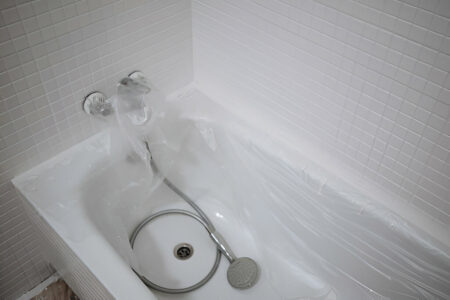We’ve all been there: standing ankle-deep in water because the bath drain just won’t do its job. A blocked bath drain can turn a relaxing soak into a frustrating mess. Not only is it inconvenient, but it can also lead to unpleasant odors and even water damage. Keeping your bath drain clear is crucial for maintaining a clean and functional bathroom.
Understanding the Problem
What Causes a Blocked Bath Drain?
A blocked bath drain can be caused by a variety of factors. The most common culprits include hair, soap scum, and dirt. Over time, these substances can accumulate and form a stubborn clog. In some cases, small objects like shampoo bottle caps or toys can also find their way down the drain and cause a blockage.
Symptoms of a Blocked Bath Drain
How do you know if your bath drain is blocked? Here are some telltale signs:
- Water drains slowly or not at all.
- You hear gurgling sounds coming from the drain.
- There’s an unpleasant odor emanating from the drain.
- Water backs up into the tub when using other plumbing fixtures.
DIY Solutions for Unblocking a Bath Drain
Before calling in a professional, there are several DIY methods you can try to unblock your bath drain.
Tools You Will Need
To tackle a blocked bath drain, you’ll need a few basic tools:
- Plunger
- Baking soda
- Vinegar
- Drain snake (also known as a plumber’s auger)
- Chemical drain cleaner (as a last resort)
- Bucket and gloves
Step-by-Step Guide
Method 1: Using a Plunger
- Remove the drain cover.
- Fill the tub with enough water to cover the bottom of the plunger.
- Place the plunger over the drain and pump it up and down vigorously.
- Check to see if the water starts to drain. If not, repeat the process a few more times.
Method 2: Baking Soda and Vinegar
- Pour a pot of boiling water down the drain.
- Follow it with 1 cup of baking soda and let it sit for a few minutes.
- Pour 1 cup of vinegar down the drain and cover it with a plug.
- Wait for 10-15 minutes, then flush with hot water again.
Method 3: Drain Snake
- Insert the drain snake into the drain until you feel resistance.
- Rotate the snake to break up the clog and pull it out.
- Repeat if necessary until the drain is clear.
Method 4: Chemical Drain Cleaners
- Follow the instructions on the product label.
- Use gloves and ensure the room is well-ventilated.
- Pour the cleaner down the drain and wait as directed.
- Flush with water to see if the blockage is cleared.
Preventative Measures
Regular Maintenance Tips
Preventing a blockage is much easier than dealing with one. Here are some tips to keep your bath drain clear:
1. Cleaning the Drain Cover Regularly
One of the simplest yet most effective maintenance tips is to clean your drain cover regularly. Hair, soap scum, and other debris often get caught in the cover, leading to blockages if not removed. Take a few minutes every week to remove the drain cover and clean off any accumulated gunk. This small effort can prevent a lot of trouble down the line.
2. Using Drain Screens
Drain screens are an excellent investment for anyone looking to prevent clogs. These screens sit over your drain and catch hair, soap fragments, and other debris before they can enter your plumbing. Make it a habit to clean these screens every few days or after every bath to ensure they function effectively.
Cleaning the Drain Cover
Regularly remove and clean the drain cover to prevent hair and debris from accumulating.
Using Drain Screens
Install drain screens to catch hair and other particles before they go down the drain.
Monthly Baking Soda and Vinegar Rinse
Pour a cup of baking soda followed by a cup of vinegar down the drain each month. This can help break down any buildup before it becomes a problem.
Habits to Avoid
Pouring Grease Down the Drain
Avoid pouring grease or oil down the drain, as it can solidify and cause blockages.
Flushing Large Debris
Don’t flush large items like hair clumps or paper towels down the drain. Dispose of these in the trash instead.
When to Call a Professional
Sometimes, DIY methods just aren’t enough. Here are signs that it’s time to call a plumber:
- The clog persists despite your best efforts.
- You notice multiple drains in your home are backed up.
- There’s a strong odor that won’t go away.
- You hear strange noises coming from your pipes.
Choosing a Reliable Plumber
When choosing a plumber, look for the following:
- Good reviews and recommendations.
- Proper licensing and insurance.
- Fair pricing and transparency about costs.
- Experience with similar issues.
FAQs
How often should I clean my bath drain? It’s a good idea to clean your bath drain at least once a month to prevent buildup.
Can a blocked bath drain cause damage to my plumbing? Yes, a severe blockage can cause water to back up and potentially damage your plumbing system.
Are chemical drain cleaners safe to use regularly? Chemical drain cleaners should be used sparingly as they can damage pipes over time.
What is the best way to prevent future blockages? Regular maintenance, using drain screens, and avoiding flushing large debris are the best ways to prevent blockages.
How do I find a good plumber? Look for a plumber with good reviews, proper licensing, and fair pricing. Personal recommendations can also be very helpful.
Conclusion!!
A blocked bath drain can be a real headache, but with the right tools and techniques, you can often resolve the issue yourself. Regular maintenance and being mindful of what goes down your drain are key to preventing future blockages. Remember, when in doubt, don’t hesitate to call a professional.




